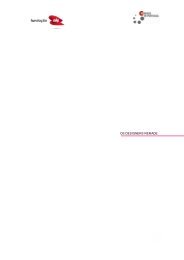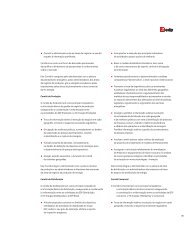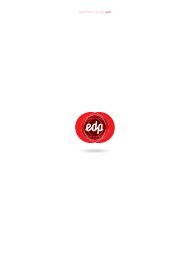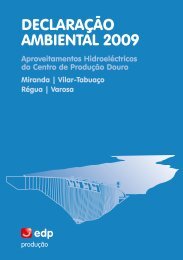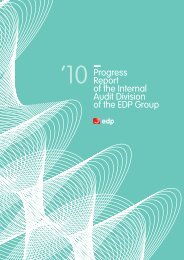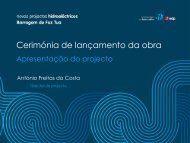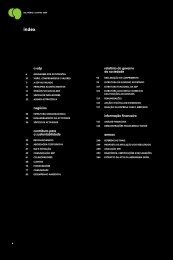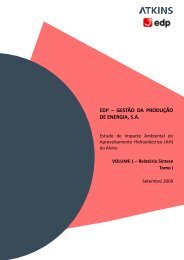notes to the <strong>EDP</strong> consolidated - Energias de Portugal, and company S.A. financial statementsfor the years ended 31 december 2012 and 2011Notes to the Consolidated and Company Financial Statementsfor the years ended 31 December 2012 and 2011IAS 28 (Amended) - Investments in Associates and Joint VenturesThe International Accounting Standards Board (IASB) issued in May 2011, IAS 28 (Amended) - Investments in Associates and Joint Ventures, with effective date ofmandatory application for periods beginning on or after 1 January 2014, being allowed its early adoption.This amendment to IAS 28 (2003) describes the accounting treatment to be adopted by the investor in associates and joint ventures, defining the accountingrequirements for applying the equity method for both associates and joint ventures.No significant impact in the Group is expected from the adoption of this change.IAS 32 (Amended) - Financial Instruments: Presentation - Offsetting Financial Assets and Financial LiabilitiesThe International Accounting Standards Board (IASB) issued in December 2011, IAS 32 (Amended) - Financial Statements: Presentation - Offsetting Financial Assets andFinancial Liabilities, with effective date of mandatory application for periods beginning on or after 1 January 2014, being allowed its early adoption.This amendment clarifies the required conditions to be met in order to present the net position of the financial assets and liabilities in the financial position of an entity,as follows: (i) the entity currently has a legally enforceable right to set off the recognized amounts, and (ii) the entity has the intention to settle on a net basis or to realisethe asset and settle the liability simultaneously.No significant impact in the Group is expected from the adoption of this change.Investment Entities - Amendments to IFRS 10, IFRS 12 and IAS 27The International Accounting Standards Board (IASB), issued in October 2012, Investment Entities - Amendments to IFRS 10, IFRS 12 and IAS 27, with effective date ofmandatory application for periods beginning on or after 1 January 2014, being allowed its early adoption. These amendments, have not yet been adopted by theEuropean Union.IASB defines the term "investment entity" as an entity whose business purpose is to invest funds solely for returns from capital appreciation, investment income or both,and must evaluate the performance of its investments on a fair value basis.The amendments provide an exception to the consolidation requirements in IFRS 10 and require investment entities to measure particular subsidiaries ar fair valuethrough profit or losses, rather than consolidate them these amendments also set out the disclosure requirements for investment entities.No significant impact in the Group is expected from the adoption of these amendments.IFRS 9 - Financial InstrumentsThe International Accounting Standards Board (IASB) issued in November 2009, IFRS 9 - Financial instruments part I: Classification and measurement, with effectivedate of mandatory application for periods beginning on or after 1 January 2015, being allowed its early adoption. This standard, changed in October 2010, has not yetbeen adopted by the European Union.This standard is included in phase I of the IASB's comprehensive project to replace IAS 39 and relates to issues of classification and measurement of financial assets.The main issues considered are as follows:- the financial assets can be classified in two categories: at amortised cost or at fair value. This decision will be made upon the initial recognition of the financial assets.Its classification depends on how the entity presents these financial assets and the contractual cash flows associated to each financial asset in the business;- debt instruments model can be measured at amortised cost when the contractual cash-flows represent only principal and interest payments, which means that itcontains only basic loan features, and for which an entity holds the asset to collect the contractual cash flows. All the other debt instruments are recognised at fairvalue;- equity instruments issued by third parties are recognised at fair value with subsequent changes recognised in the profit and loss. However an entity could irrevocablyelect equity instruments at initial recognition for which fair value changes and the realised gain or loss are recognised in fair value reserves. Gains and lossesrecognised in fair value reserves can not be recycled to profit and loss. This is a discretionary decision, and does not imply that all the equity instruments should betreated on this basis. The dividends received are recognised as income for the year;- there is no exemption that allows unquoted equity investments and related derivatives to measure at cost, under IAS 39, is not allowed in IFRS 9;- changes in fair value attributable to own credit risk of financial liabilities classified as fair value through profit or loss, shall be recognised in Other comprehensiveincome. The remaining fair value changes related to these financial liabilities shall be recognised through profit or loss. The amounts recognised in Othercomprehensive income shall not be reclassified/transferred to profit and loss.The Group is evaluating the impact of adopting this standard.<strong>EDP</strong> - <strong>Annual</strong> <strong>Report</strong> 2012251
notes to the consolidated <strong>EDP</strong> - and Energias company de Portugal, financial S.A. statementsfor the Notes years to the ended Consolidated 31 december and Company 2012 Financial and Statements 2011for the years ended 31 December 2012 and 201151. <strong>EDP</strong> BRANCH IN SPAINThe aim of "<strong>EDP</strong> - Energias de Portugal - Sociedade Anónima, Sucursal en España" is to manage and coordinate the energy interests of subsidiaries depending from<strong>EDP</strong> Group in Spain, organised through managing and monitoring structures, in order to ensure the maximum synergy and value creation in the operations andactivities in Spain, also assuming itself as an organizational platform to lead the Iberian integration of shared and support services (back and middle offices). On thisbasis, the majority interests in <strong>EDP</strong> Renováveis, S.A., <strong>EDP</strong> Servicios Financieros España, S.A. and HC Energia (Hidroeléctrica del Cantábrico S.A.), as well as the indirectmajority interest in NG Energia (Naturgás Energia Grupo S.A.), are directly allocated to the assets of <strong>EDP</strong> Sucursal.The Spanish branch of <strong>EDP</strong> has offices in Madrid and Oviedo. From a formal and legal point of view, the representation of the Spanish branch of <strong>EDP</strong> before thirdparties is ensured through the permanent representatives, which are members of the Executive Board of Directors of <strong>EDP</strong>, mandated for that purpose.The structure of direction, coordination, management and representation of the Spanish branch of <strong>EDP</strong> is composed of an Executive Committee, a ManagementCommittee and direct representation on iberian ambit <strong>EDP</strong> Management Committee.The Executive Committee of <strong>EDP</strong> is composed essentially of five permanent representatives, a Corporate General Director (Group Controller for the activities in Spain)and by first line directors of the business units in Spain, which constitute the main direction and coordination body of the Branch, being responsible for thecoordination of the activities of the permanent representatives and of the Management Committee. The Management Committee is chaired by the Corporate GeneralDirector and is composed by the natural extension of the Departments of the Corporate Centre of <strong>EDP</strong>, namely the Department of M&A ("Direcção de Análise deNegócios"), Department of Legal Affairs ("Direcção de Assessoria Jurídica"), Department of Internal Audit ("Direcção de Auditoria"), Department of Spanish Tax Matters("Direcção de Fiscalidade Espanhola"), Department of Financial Management ("Direcção de Gestão Financeira"), Department of Commercial Shared Services ("Direcçãode Serviços Partilhados Comerciais"), Department of Corporate Shared Services ("Direcção de Serviços Partilhados Corporativos") and IT Department ("Direcção deSistemas de Informação") and "Share <strong>EDP</strong> Project" ensuring in a homogeneous way the functions of these departments transversally to the Spanish territory. Lastly, theSpanish branch of <strong>EDP</strong> has direct representation on iberian ambit <strong>EDP</strong> Management Committee particularly the Energy Planning Committees, Price and Volume,Markets, Distribution Networks, Commercial and Production.The condensed statement of financial position of the Branch as at 31 December 2012 and 2011 is analysed as follows:<strong>EDP</strong> BranchThousands of Euros Dec 2012 Dec 2011Investments in subsidiaries<strong>EDP</strong> Renováveis, S.A. 2,939,889 2,939,889Hidroeléctrica del Cantábrico, S.A. 1,981,798 1,981,798<strong>EDP</strong> Servicios Financieros España, S.A. 482,695 481,695<strong>EDP</strong> Investments and Services, S.L. 281,854 -Other 60 60Deferred tax assets 54,636 65,859Other debtors and others assets 129,006 79,794Total Non-Current Assets 5,869,938 5,549,095Trade receivables 10,985 13,573Debtors and other assets 325,212 387,595Tax receivable 43,943 37,306Cash and cash equivalents 361 11,649Total Current Assets 380,501 450,123Total Assets 6,250,439 5,999,21852. ENVIRONMENTAL MATTERSEquity 2,515,135 2,269,465Trade and other payables 3,006,023 2,436,252Total Non-Current Liabilities 3,006,023 2,436,252Trade and other payables 726,998 1,293,150Tax payable 2,283 351Total Current Liabilities 729,281 1,293,501Total Liabilities 3,735,304 3,729,753Total Equity and Liabilities 6,250,439 5,999,218Expenses of an environmental nature are those identified and incurred to avoid, reduce or repair damage of an environmental nature resulting from the company'snormal activity.Expenses of an environmental nature are recorded as expenses for the year, except if they qualify for capitalization under the terms of IAS 16.252A World Full Of Energy
- Page 1:
Impresso em papel elaborado com cel
- Page 6 and 7:
: edp :index6 edp6 message to share
- Page 8 and 9:
: edp :EDP - Annual Report 20127
- Page 10 and 11:
Portugalrenewablesgás7,194 Employe
- Page 12 and 13:
: edp :1.1.3. CORPORATEBODIESboard
- Page 14 and 15:
: edp :1.1.5. principles ofsustaina
- Page 16 and 17:
: edp :BRAzILEDP Brasil distinguish
- Page 18 and 19:
: edp :1.3.2. Operating HighlightsU
- Page 20:
: edp :1.3.5. ENVIRONMENT INDICATOR
- Page 24 and 25:
: edp :strategicframeworkxxxxxxxxxx
- Page 26 and 27:
: strategic framework :Reconversion
- Page 28 and 29:
: strategic framework :EVOLUTION OF
- Page 30 and 31:
: strategic framework :million at D
- Page 32 and 33:
: strategic framework :Since 2005,
- Page 34:
: strategic framework :EDP - Annual
- Page 38 and 39:
: a edp :performance38 business40 I
- Page 40 and 41:
: performance :EDP - Annual Report
- Page 42 and 43:
: performance :By the end of the ye
- Page 44 and 45:
: performance :electricity generati
- Page 46 and 47:
: performance :EDP Distribuição h
- Page 48 and 49:
: performance :electricity AND GAS
- Page 50 and 51:
: performance :Despite the increase
- Page 52 and 53:
: performance :electricity supply i
- Page 54 and 55:
: performance :In 2012, EDPR increa
- Page 56 and 57:
: performance :3.1.3. EDP BRAsILEDP
- Page 58 and 59:
: performance :EDP brasilGENERATION
- Page 60 and 61:
: performance :Distribution of comp
- Page 62 and 63:
: performance :testing the adherenc
- Page 64 and 65:
: performance :3.4.1. managementsys
- Page 66 and 67:
: performance :In Brazil, EDP has n
- Page 68 and 69:
: performance :that 117 m 3 of oil
- Page 70 and 71:
: performance :EDP has undertaken t
- Page 72 and 73:
: performance :encourages professio
- Page 74 and 75:
: performance :The set of indicator
- Page 76 and 77:
: performance :Voice of the custome
- Page 78 and 79:
: performance :(ACAPO), are also av
- Page 80 and 81:
: performance :3.7. suppliersThe pe
- Page 82 and 83:
: performance :Transparency; Leader
- Page 84 and 85:
: performance :The following table
- Page 86:
: performance :between the local au
- Page 90 and 91:
: a edp :Corporate governance89 sta
- Page 92 and 93:
: corporate governance :STATEMENT O
- Page 94 and 95:
: corporate governance :STATEMENT O
- Page 96 and 97:
: corporate governance :I. GENERALM
- Page 98 and 99:
: corporate governance :In all othe
- Page 100 and 101:
: corporate governance :II.1.1. Cor
- Page 102 and 103:
: corporate governance :The company
- Page 104 and 105:
: corporate governance :Strategy Co
- Page 106 and 107:
: corporate governance :Companies C
- Page 108 and 109:
: corporate governance :From 22 Feb
- Page 110 and 111:
: corporate governance :The Institu
- Page 112 and 113:
: corporate governance :Careers, Mo
- Page 114 and 115:
: corporate governance :Commercial
- Page 116 and 117:
: corporate governance :Corporate S
- Page 118 and 119:
: corporate governance :new matters
- Page 120 and 121:
: corporate governance :with the Eu
- Page 122 and 123:
: corporate governance :unavailabil
- Page 124 and 125:
: corporate governance :in share ca
- Page 126 and 127:
: corporate governance :II.19. Posi
- Page 128 and 129:
: corporate governance :II.26. Rule
- Page 130 and 131:
: corporate governance :II.28. Posi
- Page 132 and 133:
: corporate governance :Executive B
- Page 134 and 135:
: corporate governance :EDP has no
- Page 136 and 137:
: corporate governance :CHAPTER III
- Page 138 and 139:
: corporate governance :III.3. Hold
- Page 140 and 141:
: corporate governance :Share price
- Page 142 and 143:
: corporate governance :Capital Mar
- Page 144 and 145:
: corporate governance :III.13. Int
- Page 146 and 147:
: corporate governance :In 2012, th
- Page 151 and 152:
EDP Renováveis opensfirst wind far
- Page 153 and 154:
: financial report :5.1. edp group
- Page 155 and 156:
: financial report :these impacts,
- Page 157 and 158:
: financial report :local currency,
- Page 159 and 160:
: financial report :amount of EUR 1
- Page 161 and 162:
: financial report :EDP - Energias
- Page 163 and 164:
: financial report :EDP - Energias
- Page 165 and 166:
: financial report :EDP - Energias
- Page 167 and 168:
: financial report :EDP - Energias
- Page 169 and 170:
: financial report :EDP - Energias
- Page 171 and 172:
12.pdf 1 02/04/13 14:50notes to the
- Page 173 and 174:
notes to the consolidated EDP and -
- Page 175 and 176:
notes to the consolidated EDP and -
- Page 177 and 178:
notes to the consolidated and compa
- Page 179 and 180:
notes to the consolidated EDP and -
- Page 181 and 182:
notes to the consolidated EDP and -
- Page 183 and 184:
notes to the consolidated EDP and -
- Page 185 and 186:
notes to the consolidated EDP and -
- Page 187 and 188:
notes to the consolidated EDP and -
- Page 189 and 190:
notes to the consolidated EDP and -
- Page 191 and 192:
notes to the consolidated EDP and -
- Page 193 and 194:
notes to the consolidated EDP - and
- Page 195 and 196:
notes to the consolidated EDP and -
- Page 197 and 198:
notes to the consolidated EDP - and
- Page 199 and 200:
notes to the consolidated EDP - and
- Page 201 and 202: notes to the consolidated EDP - and
- Page 203 and 204: notes to the consolidated EDP and -
- Page 205 and 206: notes to the consolidated EDP - and
- Page 207 and 208: notes to the consolidated EDP - and
- Page 209 and 210: notes to the consolidated and compa
- Page 211 and 212: notes to the consolidated EDP - and
- Page 213 and 214: notes to the consolidated EDP - and
- Page 215 and 216: notes to the consolidated EDP - and
- Page 217 and 218: notes to the consolidated EDP - and
- Page 219 and 220: notes to the consolidated EDP and -
- Page 221 and 222: notes to the consolidated EDP and -
- Page 223 and 224: notes to the consolidated EDP - and
- Page 225 and 226: notes to the consolidated EDP - and
- Page 227 and 228: notes to the consolidated EDP - and
- Page 229 and 230: notes to the consolidated EDP - and
- Page 231 and 232: notes to the consolidated EDP and -
- Page 233 and 234: notes to the consolidated EDP - and
- Page 235 and 236: notes to the consolidated EDP and -
- Page 237 and 238: notes to the consolidated EDP - and
- Page 239 and 240: notes to the consolidated EDP - and
- Page 241 and 242: notes to the consolidated EDP - and
- Page 243 and 244: notes to the consolidated EDP - and
- Page 245 and 246: EDP - Energias de Portugal, S.A.Not
- Page 247 and 248: notes to the consolidated EDP - and
- Page 249 and 250: notes to the consolidated EDP and -
- Page 251: notes to the consolidatedEDPand- En
- Page 255 and 256: notes to the consolidated EDP and -
- Page 257 and 258: notes to the consolidated and compa
- Page 259 and 260: notes to the consolidated and compa
- Page 261 and 262: notes to the consolidated and compa
- Page 263 and 264: notes to the consolidated and compa
- Page 265 and 266: notes to the consolidated and compa
- Page 269 and 270: Hydroelectric powerplant of Bempost
- Page 271 and 272: : annexes :annexesannex Ifinal refe
- Page 273 and 274: : annexes :by Instituto Superior de
- Page 275 and 276: : annexes :Chairman of Euronext Lis
- Page 277 and 278: : annexes :basis. He was designated
- Page 279 and 280: : annexes :annex IIItransactions pe
- Page 281 and 282: : annexes :EDP’s material issues
- Page 283 and 284: : annexes :Simultaneously, the foll
- Page 285 and 286: : annexes :GRI complianceThis repor
- Page 287 and 288: : annexes :286A World Full Of Energ
- Page 289 and 290: : annexes :288A World Full Of Energ
- Page 291 and 292: : annexes :290A World Full Of Energ
- Page 293 and 294: : annexes :292A World Full Of Energ
- Page 295 and 296: : annexes :294A World Full Of Energ
- Page 297 and 298: : annexes :296A World Full Of Energ
- Page 299 and 300: : annexes :298A World Full Of Energ
- Page 301 and 302: : annexes :300A World Full Of Energ
- Page 303 and 304:
: annexes :302A World Full Of Energ
- Page 305 and 306:
: annexes :304A World Full Of Energ







